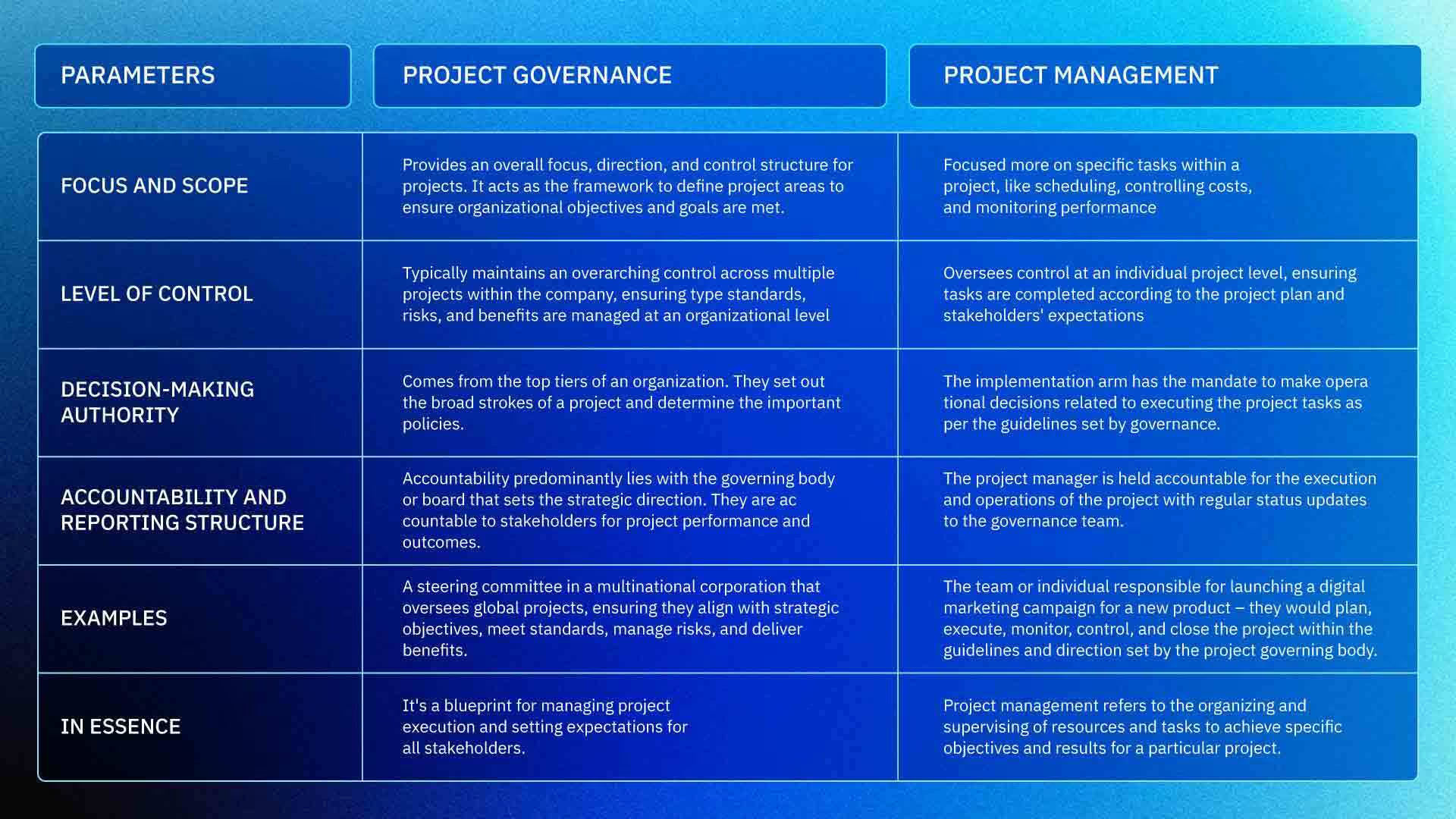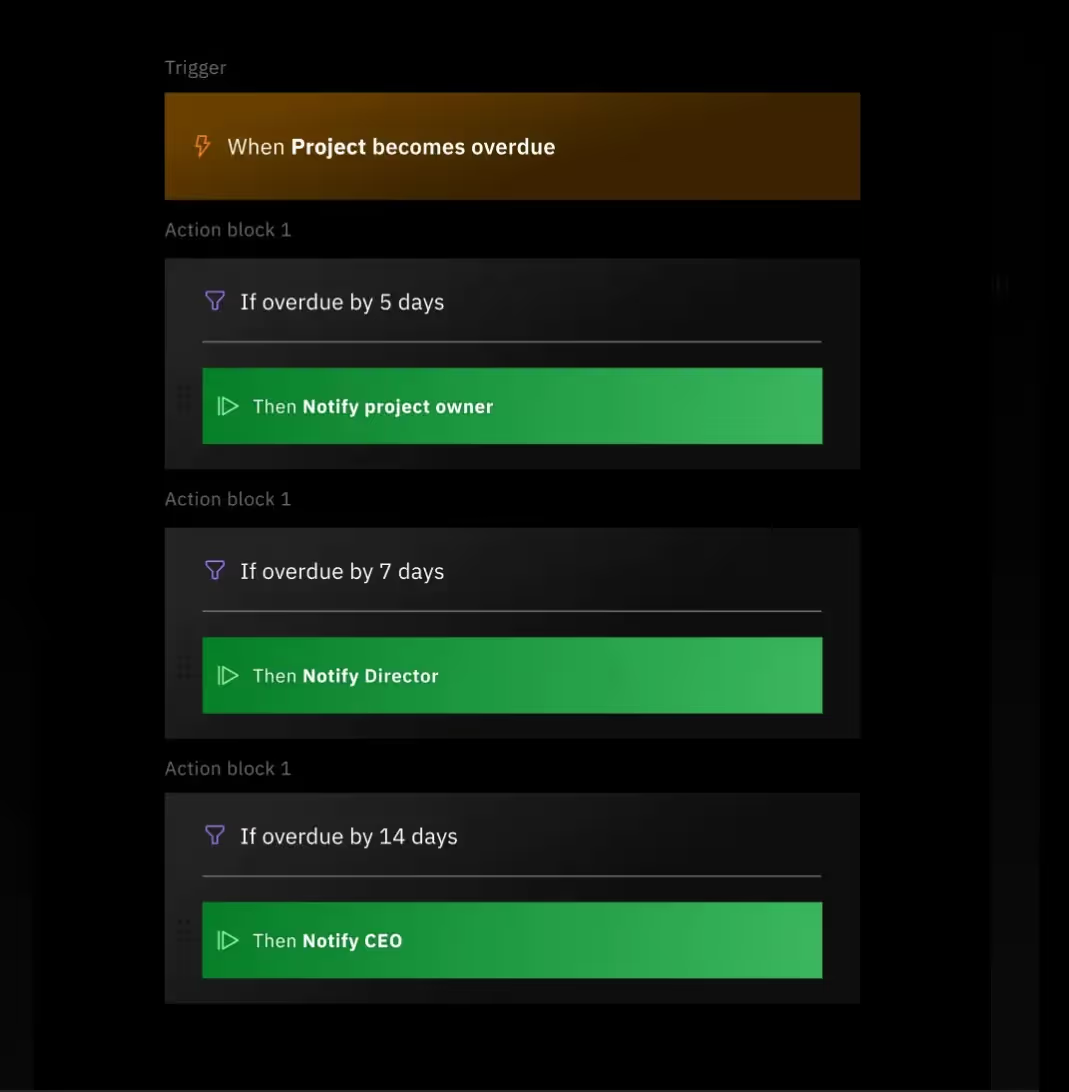In 1969, astronauts Neil Armstrong and Buzz Aldrin became the first humans to set foot on the lunar surface.
It took NASA 8 years, 10 practice missions, 40,000+ scientists, engineers, and technicians, and millions of $$$ to perfect its lunar descent. The program initially aimed to send a three-person crew to only orbit the Moon, not land on it. It was only after John F. Kennedy's famous speech in 1961 did NASA decided to send an American to the Moon and return him safely to the Earth before the end of the decade.
The success of NASA's Apollo program demonstrates that even if the initial objective was to change over a project's course, meticulous planning, management, and governance can still help you achieve your goals. Whether it is reaching for the stars or tackling everyday challenges here on Earth, NASA's approach to executing projects shows us how effective project management and governance are the backbone of any successful mission.
When executing outer space missions, NASA doesn't leave things to chance. It plans every detail carefully, follows schedules rigorously, and collaborates with teams like a well-choreographed symphony. They all come together under an intricately designed governance framework, working towards a common goal. Their governance structure ensures that key resource decisions are taken at the right time, thereby enhancing efficiency and minimizing risk.
If you would also like a glimpse of how ISRO implements projects, check out Dr. Mylswamy Annadurai's talk at Propel23.
But how does NASA weave together such an intricate web of project management and governance? How can you do the same for your projects?
This blog will dive into the specifics of project management and project governance. It will give you insights into how you can go the NASA way of executing projects with these concepts.
Importance of effective project governance and project management
Project governance and project management, although different, are both integral to the delivery of successful projects. Project governance assists in decision-making, risk management, accountability, and ensuring alignment with strategic goals. On the other hand, project management manages the delivery of the project, focusing on planning, organizing, and managing resources to successfully complete specific project objectives. Both these elements work hand in hand to drive projects towards successful outcomes.
Why differentiate between project management and project governance?
Knowing the difference between project governance and project management is important in designing an effective project delivery framework. With governance, you establish the right strategies and policies, while management handles the execution and completion of project tasks. Each serves a different purpose and both are essential for project success. They hold the potential to vastly improve your project outcomes.
Project management
What is project management?
Project management refers to the organizing and supervising of resources and tasks to achieve specific objectives and results. Its main goal is to ensure the successful execution of strategic goals set by an organization, within the set time and budget.
By implementing effective project management practices, businesses can increase their chances of success. It enables teams to work together more efficiently, ensuring that everyone is on the same page and heading in the right direction. Project management also helps minimize risks and allows for better decision-making, ultimately adding value to the organization.
Why is project management important?
Effective project management contributes significantly to organizational success. It enables teams to work within time, cost, and quality constraints, thereby improving client satisfaction. It reduces project risks and prevents cost and time overruns. By ensuring efficient use of resources, it also boosts the return on investment.
What are the phases involved in project management?
Project management is like putting together a puzzle. You gather all the pieces, figure out the best way to assemble them, and make sure everything fits perfectly. But how do you actually manage a project? Well, let's break it down into its different elements and phases.
Step 1: The initiation phase
This is where you define the project scope and get the green light to proceed. Think of it as the moment when you say, "Alright, folks, we're doing this!" It's all about setting clear goals and getting authorization from the higher-ups.
Step 2: The planning phase
Once you've got the green light, it's time to dive into the planning. This phase is where you map out the entire project. You figure out the best route to reach your goals, identify any potential roadblocks, and come up with a step-by-step plan to get there.
Step 3: The execution phase
In this phase, you actually start working on the project. You divide tasks among your team members, assign responsibilities, and make sure everyone knows what they need to do.
Step 4: The monitoring phase
The monitoring or controlling phase involves the project manager coming in to make sure everything is running smoothly. They keep a close eye on the progress, make adjustments if needed, and ensure that the project stays on track.
Step 5: The project delivery phase
The final phase involves tying up loose ends, getting the project over the finish line, and delivering on the expectations of clients.
Here's a free, ready-to-use project delivery template that will ensure your project's success.
Remember that all through these project phases, it's not just the project manager who is responsible for the success of a project. All team members, stakeholders, and customer champions need to align with project and company goals, and ensure they execute their assigned tasks. Each of their contributions impact a project's success.
What are some project management methodologies?
Project management methodologies are various approaches that guide a project from planning to successful completion. Different projects call for different methodologies depending on a variety of factors including the types of project, its scale, complexity, budget, team size, and project risks. Here are some of the most common project management methodologies:
- Waterfall methodology: This is one of the oldest and most straightforward methods. It's separated into sequential phases, where each phase must be completed before the next one can begin. This method is great for projects where requirements are clearly defined and unlikely to change.
- Agile methodology: Agile is a flexible, team-based approach where projects are divided into small parts, or "sprints". It encourages frequent reassessments and revisions, and is often used in software development projects where requirements may change quickly.
- Lean methodology: This methodology aims to minimize waste and maximize productivity by focusing on key tasks. It’s an excellent choice for fast-paced projects that require a constant reassessment of tasks and workflows.
- Kanban methodology: Kanban uses visual boards (physical or digital) to manage workflow. It's an effective method for real-time communication and coordination in a team, allowing everyone to see the state of every task.
- Critical Path Method (CPM): This method involves mapping out every key task that needs to be completed as part of the project, as well as the time each task will take. The 'critical path' then is the sequence of tasks that will take the longest time to complete.
**Please note: This is not an exhaustive list of all project management methodologies.
Best practices for project management
Project management streamlines processes, optimizes resource utilization, and enhances team collaboration, contributing to the success of organizational initiatives. Effective project management is crucial for the success of any project, big or small. Here are some of the best practices you can employ to ensure that your projects run smoothly and efficiently:
- Set clear and achievable goals: Clearly define measurable, specific, and realistic project goals to provide a foundation for your team. Distinct objectives make it easier to align efforts and track progress. Clearly defining project scope also prevents scope creep.
- Invest in proper planning and organization: Outline key components, including resource needs, tasks, timelines, and budgets. Prioritize tasks based on importance and deadlines to ensure focus on critical aspects.
- Maintain open and clear communication channels: Regularly organize meetings to discuss progress, address obstacles, and propose solutions. Open communication fosters collaboration among team members and stakeholders.
- Identify potential risks and come up with a risk management plan: Identify potential risks early and develop contingency plans. Staying flexible is equally crucial when it comes to managing projects. While adhering to the project plan, be ready to adapt quickly to changes or unforeseen issues, employing project management techniques when needed.
- Conduct regular reviews: Regularly review project progress using management tools, monitoring tasks and milestones. Generate reports to keep stakeholders informed. Additionally, conduct regular reviews, making necessary adjustments for continuous improvement. And document lessons learned for future reference.
These practices, tailored to factors like team size, project scope, industry, and organizational culture, contribute to effective project management.
Project governance
What is project governance?
Project governance refers to the set of processes, practices, and structures that an organization establishes to ensure the effective planning, execution, monitoring, and control of projects. It's a blueprint for managing project execution and setting expectations for all stakeholders. Project governance provides a structure for decision-making, accountability, and responsibility throughout the project lifecycle.
But project governance isn't just about making things run smoothly. It's about achieving strategic goals and delivering value to customers. When you have a solid governance framework in place, projects are more likely to be completed on time and within budget - meaning fewer financial risks and happier clients. And happy clients lead to more business and stronger relationships.
Why is project governance important?
The chief purpose of project governance is to ensure that projects are executed in an accountable and transparent manner, reducing risks and eventually achieving desired outcomes.
With a focus on ensuring clarity of scope, facilitating communication, engaging stakeholders, providing a framework for issue resolution, and defining success metrics, project governance becomes instrumental in an organization's success. It ensures everything runs smoothly and everyone knows their role. With project governance, you can bring clarity to the scope of work, communicate effectively, engage stakeholders, resolve issues, and define success metrics.
What are some key aspects of project governance?
Project governance is often implemented through a governance framework, which is a set of guidelines, policies, and procedures that dictate how projects are managed within an organization. The governance framework establishes the rules and structure necessary to maintain control over projects and ensure they contribute to the overall success of the organization. Effective project governance contributes to better decision-making, risk management, and ultimately the successful delivery of projects.
Key aspects of project governance include:
- Decision-making authority: Clearly define who has the authority to make decisions at different levels of the project. This includes delineating responsibilities for project managers, steering committees, and other stakeholders.
Pro-tip: One effective way to ensure the success of your project is to establish a steering committee. This committee should include key executives from the customer's side who not only have a clear understanding of the business value that can be unlocked from your project, but also have the authority to make swift decisions when necessary. By initiating regular meetings with this committee, whether on a weekly or bi-weekly basis, you create a space to align expectations and prevent scope creep. The steering committee, with their knowledge of the project's actual goals, can help identify and eliminate any unnecessary frills that may put the project at risk.
- Resource allocation: Efficiently allocating resources, including personnel, budget, and technology, to ensure that the project can be completed successfully within the defined constraints, is another key aspect of project governance.
- Performance measurement: Establish key performance indicators (KPIs) and metrics to assess the progress and success of the project. This involves regularly monitoring and evaluating project performance against predefined criteria.
- Stakeholder engagement: Engage and communicate with various stakeholders throughout the project lifecycle. Keep stakeholders informed, address any concerns, and ensure their input is considered in the decision-making processes.
The three pillars of project governance
Project governance serves as the compass for project management, encompassing guidelines, roles, and responsibilities that steer projects towards successful completion while aligning on organizational goals. Here are three fundamental pillars of project governance:
1. Strategic alignment: Ensuring projects align with organizational objectives
The first pillar, strategic alignment, involves ensuring that all projects are attuned to the broader objectives of the organization. This is crucial for ensuring resources and efforts are not wasted on initiatives that go off-tangent from the overall strategic plan. It involves:
- Having a clear understanding of the organization's strategic goals
- Ensuring projects align with these goals
- Prioritizing projects based on their strategic importance
2. Risk management: Identifying and mitigating potential risks
The second pillar, risk management, serves to identify, analyze, and mitigate potential risks that could derail a project. Effective risk management can determine if the project has to be adjusted or if an alternative approach might render better results. Risk management involves:
- Risk identification to pinpoint any potential threats
- Risk assessment to analyze the possible impact and probability of the risks
- Drawing up measures to mitigate the effects of risks on the project
3. Value delivery: Maximizing the value of projects to the organization
The third pillar, value delivery, focuses on ensuring the project delivers maximum value to the organization. This is gauged by measuring the project's outputs against the intended benefits. It involves:
- Regular project audits to ensure the ongoing alignment with organizational goals
- Implementation of project tracking metrics to measure the project’s performance
- Regular reviews of the project's delivered value against the goals set at the onset
Project governance vs. project management

Why project management and project governance should go hand-in-hand
Effectively integrating project governance and project management boosts project success rates by fostering consistent, controlled management aligned with the project's strategic objectives.
When project governance and management are combined, project planning becomes stronger and more robust, as it follows pre-defined governance principles. This means that decision-making is aligned with the project's ultimate goals, which is key to achieving success.
But it doesn't stop there. The integration also helps with risk mitigation and project compliance. Project governance identifies potential risks, and management swoops in to implement plans to tackle them and keep your project on track.
Majorly, when project governance and management are interwoven, it fosters continuous project improvement and learning, paving the way for better future projects.
Integrating project management with project governance gives you a winning combination that enhances project execution and increases the likelihood of project success.
5 easy tips for effective project management and project governance
To ensure the successful delivery of project objectives, organizations must implement effective project governance and management strategies. This involves a more comprehensive approach that seamlessly dovetails both governance and management responsibilities. The following are some best practices for implementing effective project governance and management:
1. Establish clear roles and responsibilities
Every project consists of different roles, such as project managers, project team members, stakeholders, and governance committees. Each role has distinctive responsibilities, and it's crucial to define these clearly from the outset. A failure to define roles and responsibilities can lead to confusion, missed objectives, and duplication of efforts. The project governance team generally oversees strategic direction, while the project management team handles day-to-day operations, including task allocation, status updates, and issue resolution. Thus, delineating responsibilities enhances coordination and boosts project success rates.
|Learn how you can create a responsibility assignment chart or matrix for a project.
2. Streamline collaboration and communication
Collaboration is a key aspect of both project governance and management. Team members need to communicate effectively to avoid misunderstandings and ensure timely completion of tasks. Streamlining information flow via meetings, updates, and regular check-ins aids in removing bottlenecks and preventing project delays. Tools such as email, video conferencing, and project management software can facilitate smoother collaboration and communication.
3. Implement effective change management strategies
Even the best-laid project plans may require changes due to unforeseen circumstances. The capacity to manage and adapt to these changes determines the resilience and success of a project. Implementing a strong change management strategy helps to analyze the impact of changes, devise response tactics, and diminish operational clutter. This involves diligently documenting changes, analyzing risks, and engaging stakeholders in decision-making processes.
4. Review and update governance structures regularly
The project governance framework must be consistently reviewed and updated as per the changing needs of the project. This ensures flexibility and adaptability to new situations and project demands. Regular reviews facilitate proactive detection of potential issues, thus allowing preventive measures and timely solutions.
5. Leverage purpose-built tools and technology like Rocketlane
Utilizing project governance and management tools can expedite task completion and assuage the burden on team members. Rocketlane, for instance, provides a robust platform for managing and tracking project tasks, timelines, milestones, and team collaboration. Such tools also offer in-built analytics features, which can offer invaluable insights into project performance and areas of improvement. Utilizing such tools can greatly increase the efficiency and success rate of project completion.
How Rocketlane can help with your project governance and project management
While project governance establishes decision-making frameworks and ensures accountability, project management translates decisions into actions, coordinating resources and helping achieve project goals. The key lies in effectively understanding and implementing both aspects, as they are interdependent: governance strengthens strategic decision-making, and management transforms decisions into actions, ensuring alignment with organizational goals. A harmonized effort between project governance and management is essential for efficient project execution and success. And Rocketlane can help you with just that!
Rocketlane can help you streamline both your project governance and management needs. It facilitates efficient decision-making with reporting insights, measures outcomes, and aligns project goals with your overall business objectives. But the icing on the cake, Rocketlane allows you to automate your everyday tasks with a click of a button, letting you work on work that truly moves the business needle.

Implementing Rocketlane is a step forward towards effective project governance, management, and ultimate project success. Hop on a call with us and see for yourself!















